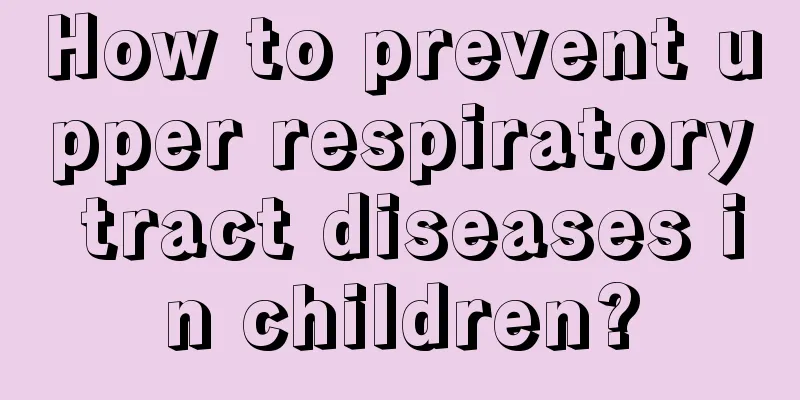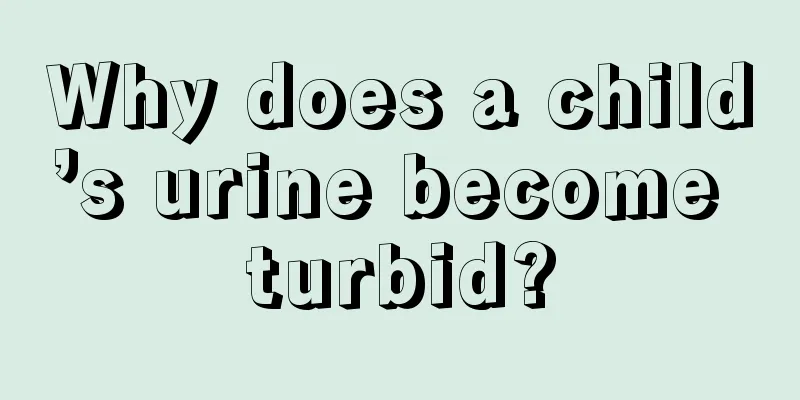What to do if your child has otitis media

|
Many mothers always complain that their children get sick easily. In fact, this is also related to the parenting methods of their parents. Pay more attention to feeding your children fruits to enhance their immunity. Don't let them take unreliable oral liquids. Nothing is better and more natural than natural food. In particular, some businesses exaggerate the functions of their products for sales, which leads to many buyers being kept in the dark. When a child really suffers from some disease, we should pay attention to the care methods of the disease. For example, otitis media often occurs in children and is caused by bacteria. As long as you pay more attention to hygiene, take good care of the child, and look after the child according to the doctor's advice, I believe the child will recover soon. Causes Acute otitis media is caused by common colds in children. Long-term rhinitis, sinusitis and adenoids hypertrophy are also common causes of acute otitis media. The vast majority of children's secretory otitis media is caused by long-term rhinitis, sinusitis and adenoids hypertrophy. Chronic otitis media often occurs secondary to acute otitis media. Trauma to the external ear and tympanic membrane can also cause chronic otitis media. Bacteria entering the middle ear through the tympanic membrane ventilation tube after tympanic tube placement can also cause chronic otitis media. Clinical manifestations Acute otitis media may have systemic symptoms such as chills, fever, fatigue and loss of appetite. Children often have gastrointestinal symptoms such as vomiting and diarrhea. Once the eardrum is perforated, the body temperature will gradually drop and systemic symptoms will be significantly alleviated. Earache is the most common manifestation of acute suppurative otitis media in children. It is often pain deep in the ear that gradually worsens, such as throbbing or stabbing pain. The earache worsens when swallowing and coughing. Children often become irritable and unable to sleep at night because of this. After the eardrum perforated and pus discharged, the ear pain was relieved immediately. Otorrhea occurs after perforation of the tympanic membrane. It is initially bloody and then becomes mucopurulent. Hearing loss is often mild and is often masked by severe ear pain. In the early stage of physical examination, congestion can be seen in the flaccid part of the tympanic membrane, and radially dilated blood vessels can be seen around the handle of the malleus and the tense part. Then the tympanic membrane becomes diffusely congested, swollen, and bulges outward, making normal signs difficult to recognize. Before the tympanic membrane perforates, small yellow spots appear locally. At the beginning, the perforation is small and difficult to see clearly. Sometimes, there are flickering and pulsating bright spots on the surface of the eardrum. Then the perforation becomes larger and pus is discharged. There is tenderness in the mastoid area, and children are often uncooperative with hearing tests. Conductive hearing loss can be detected in older children. Blood examination can reveal an increase in the total white blood cell count and neutrophil granulocyte count, and the blood count may return to normal after tympanic membrane perforation. Chronic otitis media is characterized by long-term pus discharge from the ear, which may be more or less in amount and may sometimes be accompanied by bleeding and a foul odor. Perforation of the pars flaccida or pars tense of the tympanic membrane may sometimes result in the observation of granulation tissue or cholesteatoma epithelium in the tympanic cavity or external auditory canal. Hearing tests generally show varying degrees of conductive hearing loss. Hearing loss is a common manifestation of secretory otitis media in children. Hearing loss is usually mild, and children are insensitive to sounds and usually do not report hearing loss. They are often brought to the doctor by their parents because of poor concentration and poor academic performance. If one ear is affected, it may not be noticed for a long time and may only be discovered during a physical examination. A feeling of stuffiness in the ears and tinnitus are also common clinical manifestations of this disease, which can be temporarily relieved by pressing the tragus. Examination revealed that negative pressure in the tympanic cavity caused the flaccid part or the entire tympanic membrane to recede, the handle of the malleus shifted posteriorly and superiorly, and the short process of the malleus protruded outward; when fluid accumulated in the tympanic cavity, the tympanic membrane lost its normal luster and became light yellow or amber, and sometimes the fluid level could be seen through the tympanic membrane. Tuning fork test and pure tone audiometry showed conductive hearing loss. The degree of hearing loss varies, and in severe cases it can reach around 40dBHL. Hearing improved immediately after the effusion was drained. Acoustic impedance is of great value in diagnosis. The flat type is the typical curve of otitis media with effusion, and the high negative pressure type shows poor Eustachian tube function and some tympanic effusion. Treatment Treatment of acute otitis media in children The principles of treatment for acute otitis media in children are to control infection, ensure smooth drainage and treat the cause. Use sufficient antibiotics to control infection early. After tympanic membrane perforation, obtain pus for bacterial culture and drug sensitivity test, and select sensitive antibiotics. Ephedrine nasal drops are used to reduce swelling in the pharyngeal opening of the Eustachian tube to facilitate drainage. At the same time, you should pay attention to rest, adjust your diet and receive systemic supportive treatment. Before the tympanic membrane perforates, phenol glycerin ear drops can be used locally to reduce inflammation and relieve pain. However, since this drug is corrosive to the middle ear mucosa, it should be stopped immediately after the tympanic membrane perforates. If the symptoms are severe, the tympanic membrane is obviously bulging, and there is no significant relief after treatment, a myringotomy can be performed under sterile conditions to facilitate drainage. After the eardrum is perforated, the pus in the external auditory canal should be thoroughly cleaned and antibiotic aqueous solution should be used locally. After the infection is controlled, the perforation will usually heal on its own. If the inflammation is confirmed to have subsided but the perforation has not healed for a long time and has turned into chronic otitis media, tympanoplasty can be performed. At the same time, nasopharyngeal or nasal diseases should be actively treated; such as adenoidectomy, inferior turbinate surgery, etc. Treatment of chronic otitis media in children Local treatment of chronic otitis media includes medication and surgery. Different methods are used according to different types. 1. Simple type: mainly local medication. The perforation may heal itself after the pus discharge stops and the ear is completely dry. If the perforation does not heal, tympanoplasty or tympanoplasty may be performed. (1) Local medication: Select drugs according to different pathological conditions: ① Antibiotic aqueous solution or a mixture of antibiotics and steroid hormones, such as 0.25% chloramphenicol solution, chloramphenicol cortisone solution, 3% clematisin solution, 1% berberine solution, etc., for use when the tympanic mucosa is congested, edematous, and has pus or sticky pus. ② Alcohol or glycerin preparations, such as 4% boric acid alcohol, 4% boric acid glycerin, 2.5-5% chloramphenicol glycerin, etc., are suitable for those with gradually subsiding mucosal inflammation, very little pus, and edema and moisture of the middle ear mucosa. ③ Powders, such as boric acid powder, chloramphenicol boric acid powder, etc., are only used when the perforation is large and there is very little pus, and they help dry the ears. (2) Precautions for topical medication: ① Before using the medication, clean the pus in the external auditory canal and middle ear cavity. You can use 3% hydrogen peroxide or boric acid water for cleaning, then wipe it clean with a cotton swab or use an aspirator to absorb all the pus before dripping the medication. ② Antibiotic ear drops should be selected based on the results of bacterial culture and drug sensitivity test of middle ear pus. Aminoglycoside antibiotics used locally in the middle ear can cause inner ear poisoning and should be used with caution or as little as possible. ③ Powder should be used sparingly. Powder should have fine particles and be easily soluble. Do not use too much at one time. Just sprinkle a thin layer into the tympanic cavity. It is not recommended to use this product if the perforation is small or if there is a lot of pus, as the powder may clog the perforation and hinder drainage. Ear drop method: The patient sits or lies down with the affected ear facing upwards. Gently pull the auricle backward and upward, and drip 3 to 4 drops of medicine into the external auditory canal. Then press the tragus lightly with your fingers several times to encourage the medicine to flow into the middle ear through the perforation of the eardrum. You can change your position after a few minutes. Note that the ear drops should be as close to body temperature as possible to avoid causing dizziness. (3) To improve hearing, tympanoplasty or tympanoplasty can be performed, but it is best performed when the inflammation in the middle ear cavity has subsided, pus discharge has stopped for 2 to 3 months, and the Eustachian tube is unobstructed. Smaller perforations can be cauterized on an outpatient basis. Use 50% trichloroacetic acid to burn the edge of the perforation, and then apply a thin layer of covering (such as phenol glycerol cotton pads, silicone membrane, etc.) to act as a bridge, prompting the new tympanic membrane epithelium to grow and heal along the covering. Some may take several times to heal. 2. Bone ulcer type: (1) For patients with unobstructed drainage, local medication is the main treatment, but regular follow-up should be performed. (2) The granulation tissue of the middle ear can be cauterized with 10-20% silver nitrate or scraped away with a spatula, and the polyp of the middle ear can be removed with a snare. (3) For patients with poor drainage or suspected complications, modified radical mastoidectomy or radical mastoidectomy should be performed according to the extent of the lesion, and tympanoplasty should be performed at the same time to restore hearing as appropriate. 3. Cholesteatoma type: Modified radical mastoidectomy or radical mastoidectomy should be performed as soon as possible to completely remove the lesion and prevent complications in order to obtain a dry ear, and tympanoplasty should be performed as appropriate to improve hearing. Surgery 1. Chronic simple and ulcerative otitis media (1) Remove surrounding infected lesions. Hypertrophic nasal conchae, nasal polyps, deviated nasal septum, etc. that affect nasal ventilation should be surgically removed and corrected. Chronic sinusitis should be cured. Chronic tonsillitis and adenoma hypertrophy should be removed. Especially in children, adenoma hypertrophy and inflammation are the reasons for the long-term recovery of otitis media. After removal, otitis media often recovers faster. (2) The purpose of tympanoplasty is to remove lesions and restore hearing. (1) Tympanoplasty is performed 1 to 2 months after otitis media and dry ear. Choose a repair method based on the size of the puncture. ① The drug cauterization patching method is suitable for perforations less than 3mm. Use a cotton ball with Baoning solution to anesthetize the surface of the tympanic membrane locally, or use 1% lidocaine for subcutaneous infiltration anesthesia in the ear canal. Use a small roll of 50% trichloroacetic acid cotton to ablate the edge of the tympanic membrane perforation into a 1-2mm white ring. Then remove the sterilized dry amniotic membrane, egg membrane, garlic inner membrane, plastic film or dry paper, etc., apply biological glue or glycerin, and stick it on the perforated surface. Use an alcohol cotton ball to plug the external ear hole, or you can use a small gelatin sponge block to plug the perforation. After 1 to 2 weeks, remove the patch and observe. If no granulation tissue is seen at the edge of the perforation, cauterization can be performed again. Because the surface of the tympanic membrane is composed of stratified squamous epithelium, which has a strong ability to proliferate and regenerate, a small perforation can usually be successfully repaired after 2 to 3 cauterizations. ② Tissue valve transplant repair is suitable for perforations larger than 0.4 cm. There are many types of transplant materials, and it has been proven that the best is autologous mesodermal tissue, such as temporalis fascia, tragus perichondrium and mastoid periosteum. Tympanic membrane transplantation is divided into internal transplantation, external transplantation and sandwich transplantation. Under a microscope, use a small scraper or curette to scrape off 2 to 3 mm of the epithelium at the edge of the perforation. If the perforation is large and the edge is narrow, extend 2 to 3 mm from the edge of the perforation to the external auditory canal and scrape off the ear canal epithelium to create a skin donor wound. Take a small amount of gelatin sponge particles dipped in penicillin and pad them in the tympanic cavity. Take the prepared transplant and stick it on the scraped surface of the tympanic membrane. Use gelatin sponge to fill it externally. This is the explantation method. For example, if the inner mucosa of the perforated eardrum is scraped off and a graft is pasted inside the perforation, it is called endografting. The internal and external implantation methods have the same effect and can be selected according to the surgeon's preference. The sandwich method is most suitable for those with marginal perforations. A circular incision is made on the skin and the edge of the tympanic membrane in the external auditory canal near the edge of the perforation, 3 to 5 mm outside the tympanic ring. A fascia or periosteum piece is taken and implanted under the skin of the ear canal and between the surface and fibrous layer of the tympanic membrane to facilitate healing. Ossicular chain repair surgery: There are many cases of ossicular necrosis in chronic otitis media, the most common of which is the long crus of the incus. The ossicular chain should be repaired during surgery. If the long foot of the incus is necrotic, the body of the incus can be pulled down to connect with the stapes; if the incus disappears, the long process of the malleus should be transferred to connect with the stapes, or an artificial incus connection can be made; if there is only the stapes or foot plate, bird ossicles and tympanoplasty can be performed. (2) Epitympanic sinus tympanotomy is performed under local or general anesthesia. An incision is made in the ear, and the skin flap above the external auditory canal and the posterior part of the tympanic membrane are turned forward and downward to expose the lateral wall of the epitympanic cavity. The lateral wall is removed with a bone chisel or electric drill to open the entrance of the tympanic sinus and expose all bone destruction and cholesteatoma lesions. Remove all necrotic mucosa and granulation tissue, remove the necrotic part of the ossicles and cholesteatoma, cut off the hammer head, flush and stop bleeding, pull the external auditory canal skin graft back and press it toward the tympanic sinus area, and take the temporal fascia or periosteum to patch under the tympanic membrane perforation, and use iodine form strips to fill it externally. This surgery is also called modified radical mastoidectomy. (4) Radical mastoidectomy is performed under general anesthesia, but local anesthesia may also be tried. The mastoid process is very small and an incision is made inside the ear, usually behind the ear. Expose the mastoid process, use an electric drill or bone chisel to remove the entire mastoid lesion cell, and thoroughly scrape off the granulation tissue and cholesteatoma. If radical treatment is required, the tympanic sinus should be enlarged, the outer bone wall should be removed, and the bridge should be broken. The posterior bone wall of the external auditory canal should be cut to a level not lower than the incus fossa, otherwise the vertical segment of the facial nerve may be easily damaged. Perform the surgery under clear vision and avoid damaging the meningeal plate, sigmoid sinus plate, facial nerve and semicircular canals. If intracranial complications are suspected, the bone plate should be ground open for exploration even if the bone wall is intact. If the lesion is not serious and the skin of the external auditory canal is normal, the external auditory canal skin graft can be cut longitudinally from the tympanic sinus, divided into upper and lower flaps and pushed forward. It can also be completely removed and then the tympanic cavity lesion can be cleaned. It is best to do this under a microscope. In addition to retaining the stapes and round window, the necrotic mucosa, granulation tissue, necrotic ossicles, cholesteatoma and tensor tympani muscle in the tympanic cavity should be removed. If the tympanic cavity lesions are not serious, the hearing loss is not too severe, and the Eustachian tube function is normal, and the patient is expected to undergo a second-stage tympanoplasty, he or she may be slightly conservative when cleaning the diseased tissue. Otherwise, all lesions should be removed completely, especially the diseased mucosa and granulation tissue at the tympanic orifice of the Eustachian tube. Failure to completely remove them is often the main reason for continued pus discharge after surgery. Generally, after radical mastoidectomy, the external auditory canal, tympanic cavity, tympanic sinus and mastoid are connected into a large cavity. The retained skin graft of the posterior wall of the external auditory canal is divided into two upper and lower flaps, turned into the mastoid cavity, fixed on the soft tissue behind the ear, and filled with iodine-form gauze. 9 to 10 days after the operation, remove the iodine form gauze and use 4% boric acid alcohol to drip into the ear. The ear will be dry after 1 to 2 weeks. The disadvantage of leaving a large cavity after surgery is that dizziness and headaches may occur when exposed to cold or hot air and water. The grafted skin is very thin and has insufficient blood supply, which can easily lead to epithelial exfoliation, ulceration, pus discharge, or epithelial accumulation to form cholesteatoma. In order to eliminate the postoperative cavity, mastoid cavity packing was popular in the 1960s. That is, the skin of the posterior wall of the external auditory canal was kept intact, and then the nearby pedicled temporalis muscle flap and sternocleidomastoid muscle flap were taken to fill the mastoid cavity. Some people also used autologous ribs, iliac bones, or even allogeneic bones for filling. After long-term follow-up, although some cases of bone infection and detachment or muscle flap absorption, cavity reappearance, and a few cases of recurrent cholesteatoma occurred, generally no scab was produced after surgery and infection rarely occurred again, so it is still worth adopting. The principles of treatment for secretory otitis media in children are to clear middle ear effusion, improve middle ear ventilation and drainage, and treat the cause. Tympanostomy and myringotomy are not commonly used in children. Tympanostomy tube placement should be performed for children with persistent or recurrent disease, and the ventilating tube is usually left in place for more than half a year. Use ephedrine or hormone nasal drops to keep the nasal cavity and Eustachian tube open. For short-term treatment, take hormonal drugs such as prednisone. At the same time, nasopharyngeal or nasal diseases should be actively treated; such as adenoidectomy, inferior turbinate surgery, etc. After reading the entire article, I believe you have already understood the cause of otitis media. Although we didn't know anything about otitis media before, we are now familiar with this disease. As long as we handle it carefully, otitis media is not as terrible as imagined. We just need to pay more attention to environmental hygiene and living habits in daily life.
|
<<: What to do if your child has autism
>>: Does baldness on the back of the head necessarily mean calcium deficiency?
Recommend
Causes of bleeding gums in babies
After the baby is born, the joy of becoming a new...
Is it normal for a child's head to sweat a lot?
Children must be busy jumping around every day. O...
What should I do if my child has a hunchback?
Of course, parents hope that their children can g...
What should we do if children have congenital malformations?
Every parent hopes that their children will be he...
What is the developmental standard for a newborn baby at four months?
After the baby is born, as the baby's age inc...
What are the best ways to reduce fever in children?
If a child has a fever, parents will definitely b...
Why is there blue around baby's lips?
Is the blue area around the baby's lips due t...
Can a one-year-old baby eat yogurt?
Yogurt is an essential dairy product in most fami...
Why do babies have café au lait spots?
While every family is relieved about the smooth d...
A complete collection of folk remedies for treating children's cough
Coughing in children is a relatively common disea...
Why do babies yawn?
After having a baby, many young parents will pay ...
What should I do if my child is prone to prickly heat?
Sweating is the main way for people to dissipate ...
What soup is good for children to supplement calcium?
It is very necessary for children to supplement c...
What is the order in which baby teeth grow?
The order of baby's teeth growth is from 6-7 ...
Side effects of allergy treatment for children
I believe most people have experienced allergies....









